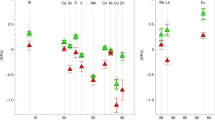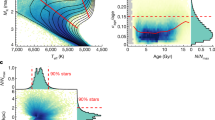Abstract
The birth of very massive stars is not well understood1,2,3, in contrast to the formation process of low-mass stars like our Sun4,5. It is not even clear that massive stars can form as single entities; rather, they might form through the mergers of smaller ones born in tight groups6,7. The recent claim of the discovery of a massive protostar in M17 (a nearby giant ionized region) forming through the same mechanism as low-mass stars8 has therefore generated considerable interest. Here we show that this protostar has an intermediate mass of only 2.5 to 8 solar masses (M⊙), contrary to the earlier claim of 20M⊙ (ref. 8). The surrounding circumstellar envelope contains only 0.09M⊙ and a much more extended local molecular cloud has 4–9M⊙.
This is a preview of subscription content, access via your institution
Access options
Subscribe to this journal
Receive 51 print issues and online access
$199.00 per year
only $3.90 per issue
Buy this article
- Purchase on Springer Link
- Instant access to full article PDF
Prices may be subject to local taxes which are calculated during checkout



Similar content being viewed by others
References
Yorke, H. W. & Sonnhalter, C. On the formation of massive stars. Astrophys. J. 569, 846–862 (2002)
Wolfire, M. G. & Cassinelli, J. P. Conditions for the formation of massive stars. Astrophys. J. 319, 850–867 (1987)
Stahler, S. W., Palla, F. & Ho, P. T. P. in Protostars and Planets IV (eds Mannings, V., Boss, A. P. & Russell, S.) 327–351 (Univ. Arizona Press, Tucson, 2000)
Mundy, L. G., Looney, L. W. & Welch, W. J. in Protostars and Planets IV (eds Mannings, V., Boss, A. P. & Russell, S.) 355–376 (Univ. Arizona Press, Tucson, 2000)
Calvet, N., Hartmann, L. & Strom, S. E. in Protostars and Planets IV (eds Mannings, V., Boss, A. P. & Russell, S.) 377–399 (Univ. Arizona Press, Tucson, 2000)
Bonnell, I. A., Bate, M. R. & Zinnecker, H. On the formation of massive stars. Mon. Not. R. Astron. Soc. 298, 93–102 (1998)
Bonnell, I. A., Vine, S. G. & Bate, M. R. Massive star formation: nurture, not nature. Mon. Not. R. Astron. Soc. 349, 735–741 (2004)
Chini, R. et al. The formation of a massive protostar through the disk accretion of gas. Nature 429, 155–157 (2004)
Padgett, D. L. et al. Hubble space telescope/NICMOS imaging of disks and envelopes around very young stars. Astron. J. 117, 1490–1504 (1999)
Felli, M., Massi, M. & Churchwell, E. A high-resolution study of M17 at 1.3, 2, 6, and 21 CM. Astron. Astrophys 136, 53–64 (1984)
Shuping, R. Y., Morris, M. & Bally, J. A new mid-infrared map of the BN/KL region using the Keck telescope. Astron. J. 128, 363–374 (2004)
Okamoto, Y. K. et al. High-resolution mid-infrared imaging and spectroscopic observations of a massive star forming region W51 IRS 2. Astrophys. J. 553, 254–266 (2001)
Ohashi, N., Hayashi, M., Ho, P. T. P. & Momose, M. Interferometric imaging of IRAS 04368 + 2557 in the L1527 molecular cloud core: A dynamically infalling envelope with rotation. Astrophys. J. 475, 211–223 (1997)
Ohashi, N. et al. Rotation in the protostellar envelopes around IRAS 04169 + 2702 and IRAS 04365 + 2535: The size scale for dynamical collapse. Astrophys. J. 488, 317–329 (1997)
Park, S. & Kenyon, S. J. Extended near-infrared emission from candidate protostars in the Taurus-Auriga molecular cloud. Astron. J. 123, 3370–3379 (2002)
Tamura, M., Gatley, I., Waller, W. & Werner, M. W. Two micron morphology of candidate protostars. Astrophys. J. 374, L25–L28 (1991)
Thi, W. F. et al. H2 and CO emission from disks around T Tauri and Herbig Ae pre-main-sequence stars and from debris disks around young stars: Warm and cold circumstellar gas. Astrophys. J. 561, 1074–1094 (2001)
Jiang, Z. et al. Deep near-infrared survey toward the M17 region. Astrophys. J. 577, 245–259 (2002)
Hanson, M. M., Howarth, I. D. & Conti, P. S. The young massive stellar objects of M17. Astrophys. J. 489, 698–718 (1997)
Nielbock, M., Chini, R., Jütte, M. & Manthey, E. High mass Class I sources in M 17. Astron. Astrophys. 377, 273–284 (2001)
Hartmann, L. Accretion Processes in Star Formation (Cambridge Univ. Press, New York, 1998)
Wilson, C. D., Howe, J. E. & Balogh, M. L. The large-scale J = 3 → 2 and J = 2 → 1 CO emission from M17 and its implications for extragalactic CO observations. Astrophys. J. 517, 174–187 (1999)
Howe, J. E. et al. Extended [C I] and 13CO (5 → 4) emission in M17SW. Astrophys. J. 539, 137–141 (2000)
Nakano, T., Hasegawa, T. & Norman, C. The mass of a star formed in a cloud core: Theory and its application to the Orion A cloud. Astrophys. J. 450, 183–195 (1995)
Kobayashi, N. et al. IRCS: infrared camera and spectrograph for the Subaru Telescope. Proc. SPIE 4008, 1056–1066 (2000)
Takami, H. et al. Performance of Subaru adaptive optics system and the scientific results. Proc. SPIE 4839, 21–31 (2003)
Kataza, H. et al. COMICS: the cooled mid-infrared camera and spectrometer for the Subaru telescope. Proc. SPIE 4008, 1144–1152 (2000)
Hogerheijde, M. R., van Dishoeck, E. F., Blake, G. A. & van Langevelde, H. J. Envelope structure on 700 AU scales and the molecular outflows of low-mass young stellar objects. Astrophys. J. 502, 315–336 (1998)
Ohashi, N., Hayashi, M., Kawabe, R. & Ishiguro, M. The Nobeyama Millimeter Array survey of young stellar objects associated with the Taurus molecular cloud. Astrophys. J. 466, 317–337 (1996)
Acknowledgements
This Letter is based on data collected at the Subaru Telescope and the Nobeyama Radio Observatory, which are operated by the National Astronomical Observatory of Japan.
Author information
Authors and Affiliations
Corresponding author
Ethics declarations
Competing interests
The authors declare that they have no competing financial interests.
Supplementary information
Rights and permissions
About this article
Cite this article
Sako, S., Yamashita, T., Kataza, H. et al. No high-mass protostars in the silhouette young stellar object M17-SO1. Nature 434, 995–998 (2005). https://doi.org/10.1038/nature03471
Received:
Accepted:
Issue Date:
DOI: https://doi.org/10.1038/nature03471
This article is cited by
Comments
By submitting a comment you agree to abide by our Terms and Community Guidelines. If you find something abusive or that does not comply with our terms or guidelines please flag it as inappropriate.



